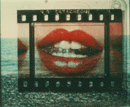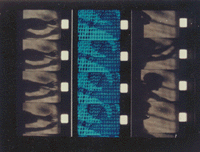

 Mental Radio - 1996 |
Albert Gabriel Nigrin is an award-winning experimental media artist whose work has been screened throughout the world. He is also a Cinema Studies Lecturer at Rutgers University, and the Executive Director/Curator of the Rutgers Film Co-op/New Jersey Media Arts Center, Inc. -- a non-profit organization which screens and promotes independent, experimental and artistic cinema in New Jersey via the New Jersey Film Festivals, and the United States Super 8mm Film + DigitalVideo Festival. |
 Sea Cocktail - 1992 (Photogram) |
Mr. Nigrin has an M.F.A. (in Visual Arts/Film and Video) and an M.A. (in French Literature) from Rutgers University and a B.A. from the State University of New York at Binghamton. Mr. Nigrin has received fellowships from the National Endowment for the Arts/ American Film Institute Mid-Atlantic Media Arts Fellowship Program and the Ford Foundation for his flm/video work. In addition, Mr. Nigrin was awarded a 2002 New Jersey State Council on the Arts Media Arts Fellowship. |
 Cold War Blues - 2024 |
Mr. Nigrin's recent work Light Pharmacy: 5/Mental Radio and Tundra) were winners at the prestigious 2000 Black Maria Film and Video Festival, No-TV 1999 Festival, Rochester, NY, the 1999-2001 Big As Life: An American History of 8mm Filmmaking retrospective at the Museum of Modern Art in New York, NY. Other works were winners at the 1997 Sinking Creek Film/Video Festival [Nashville, Tennessee], the 1997 Big Muddy Film/Video Festival [Illinois], the 1997 Atlanta International Film/Video Festival [Georgia], the 1996 VIVA 8 Film Festival [London, England], the 1996 Black Maria Film/Video Festival, the 1995 Chicago Onion City Experimental Film Festivalthe 1995 American Film Institute National Video Festival [Hollywood, CA], the 1994 American Film Institute National Video Festival [Hollywood, CA], and the 1993 Atlanta International Film and Video Festival. |
 Dream Screen - 2024
|
Albert Gabriel Nigrin Recent Experimental Media Works include: Cold War Blues or Effects of the Bomb Varied, But... (2001-In progress; 6 min.) - a playful cut-out animation focusing on the Cold War ;The Furies (1999; 26 min.) - a film about female phantoms who haunt the Raritan River in New Jersey; Tundra (1999; 3 min.-via Victory Furniture) - a film haiku focusing on blowing and billowing snow; Mental Radio (1999; 12 min.)- a personal film on Graves Disease; Art, Empire, Industry (1990-96; 13 min.); Echolalia (1990-94; 13 min.); Light Pharmacy: 4.1 (1988-93; 6 min.); Emma Woolfolk (1992; 6 min.); Shifting Margins 1 & 2 (1991; 6 min.); Brainwashing (1986; 6 min.); Terrain Vague (1987; 13 min.); The Burning Text ; Rummage (1989; 25 min.); The Burning Text (1988; 13 min.) -a film documenting a warehouse fire in Philadelphia; Aurelia (1985; 13 min); and others. |
 Terrain Vague - 1987
|
Blasted terrains of ruin, fog and water define the parameters for many of Nigrin's strangely beautiful films: the incomplete Sagrada Familia cathedral in Barcelona (Aurelia); the flooded interior of a car wash (Brainwashing); a damaged heating system in New Jersey that fills a field of grass with billowing steam (Terrain Vague); the crenelated Fonthill Mansion in Doylestown, Pennsylvania (Light Pharmacy: 4.1); a warehouse fire in Philadelphia (The Burning Text); a rustic outdoor rummage sale (Rummage); the Luxembourg Gardens in Paris (Shifting Margins); a stream in a New Brunswick gutter (Light Pharmacy: 5); a backyard in New Jersey (Mental Radio); the Raritan River in Central New Jersey (The Furies and Dream Screen); the AZULIK Uh May in Mexico (Pizzica); and Death Valley and a New Orleans cemetery (Art, Empire, Industry). |
 /Grid/Lock/Wed/Lock - 1984 (Photogram) |
These sites are transformed by Nigrin's haunting cinematography into what he calls "light-scapes" -- it is difficult to determine whether the moon or the sun produces the grey tonalities of the films. These light-scapes are fluid, provisionally drawn by the camera's angular relation to figures who move while brandishing mirrors and glass that refract light into the camera. This refraction creates sensual and kinetic forms of light: concentric circles, pinpoints, shadow stripes. Nigrin says the reflected light is "designed to make people look and turn away at the same time. By shooting light into the lens, I shoot it back into the audience, creating flashes that blank out the spectator's retina. The spectator must then etch in this voided screen to re-establish continuity in the film." --- Irene Fizer |
![]()